Where is the Izu Peninsula?
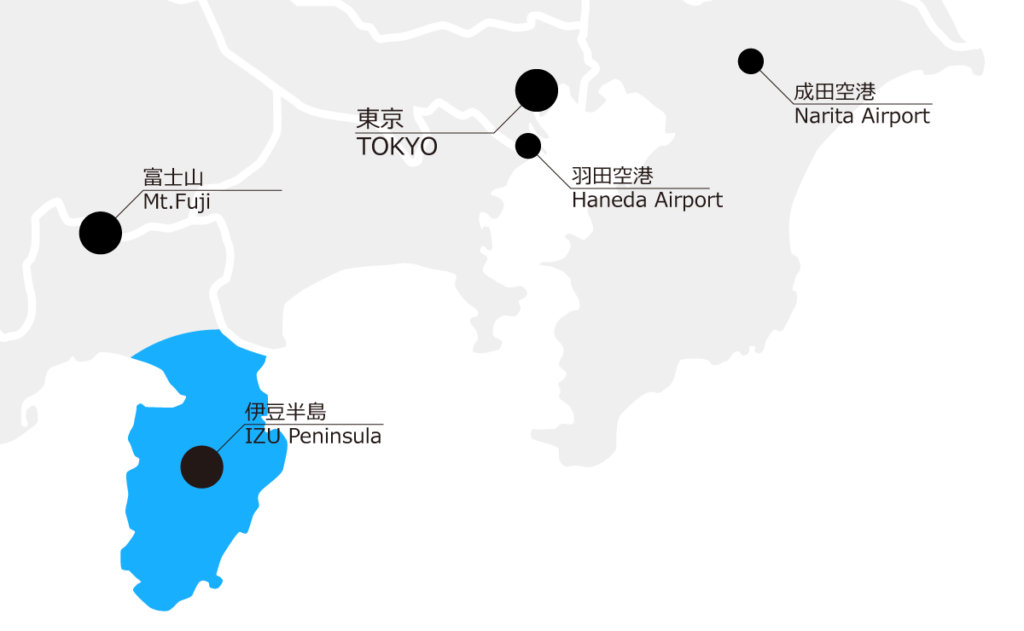
東京から伊豆半島へ
Shinkansen (Tokyo Station - Atami Station): Approx. 45 minutes (¥3,740)
Shinkansen (Tokyo Station - Mishima Station): Approx. 50 minutes (¥4,070)
Tokaido Main Line (Tokyo Station - Atami Station): Approx. 1 hour 50 minutes (¥1,980)
Tokaido Main Line (Tokyo Station - Mishima Station): Approx. 2 hours 12 minutes (¥2,310)
Tokai Bus (Busta Shinjuku - Mishima Station): Approx. 2 hours 5 minutes (¥2,100)
Tomei Expressway (Tokyo IC - Nagaizumi-Numazu IC): Approx. 1 hour 10 minutes (¥3,130)
*There are also express trains such as the "Odoriko" that run directly from Tokyo Station to Shuzenji Station and Shimoda Station.
To various places in the Izu Peninsula
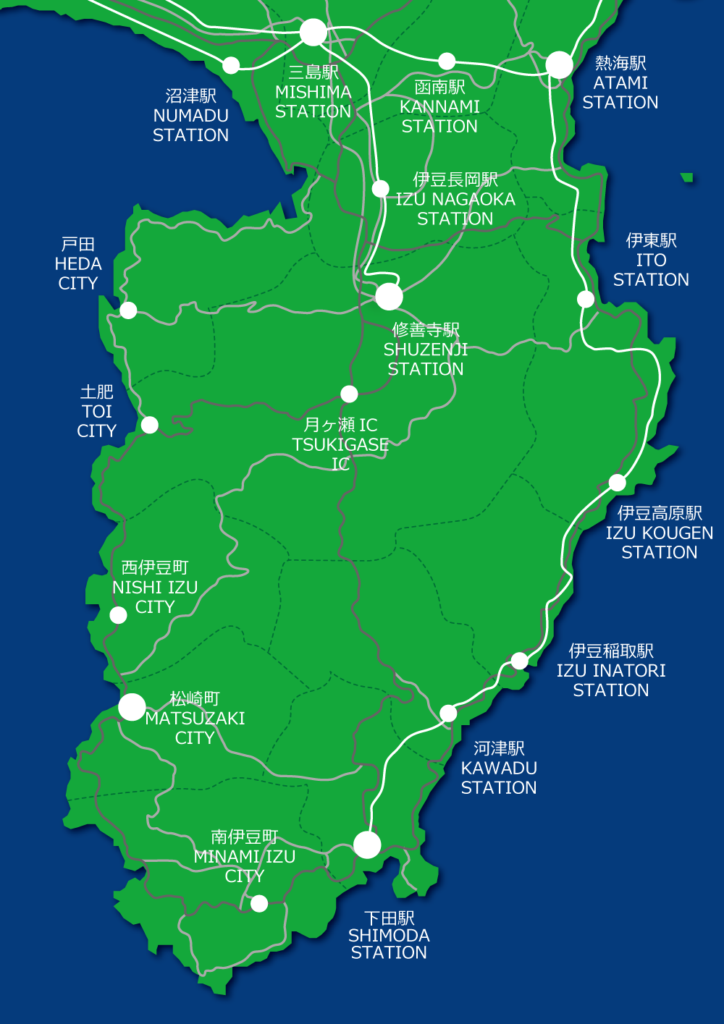
From Atami Station to Shimoda Station
JR Ito Line (Atami Station - Ito Station): Approximately 25 minutes (¥330)
Izukyu (Ito Station - Izukyu-Shimoda Station): Approximately 1 hour 5 minutes (¥1,650)
From Shimoda Station bus stop to Matsuzaki Bus Terminal
Tokai Bus (Shimoda Station Bus Stop - Matsuzaki Bus Terminal): Approximately 50 minutes (¥1,290)
From Mishima Station to Shuzenji Station
Izu Hakone Railway (Mishima Station - Shuzenji Station): Approximately 35 minutes (¥520)
From Shuzenji Station bus stop to Matsuzaki Bus Terminal
Tokai Bus (Shuzenji Bus Stop - Matsuzaki Bus Terminal): Approximately 1 hour 35 minutes (¥2,190)
*Matsuzaki Bus Terminal is closest to Mishima Station.
Car
Tomei Expressway (Tokyo IC - Nagaizumi-Numazu IC): Approximately 1 hour (approximately 102km)
Izu Longitudinal Expressway (Nagaizumi-Numazu IC - Tsukigase IC): Approximately 30 minutes (approximately 33km)
National Route 136 (Tsukigase IC - Matsuzaki Bus Terminal): Approximately 1 hour 10 minutes (approximately 57km)
National Route 414 (Tsukigase IC - Shimoda Station): Approximately 1 hour (approximately 42km)
Prefectural Route 15 (Shimoda Station - Matsuzaki Bus Terminal): Approximately 35 minutes (approximately 26km)
To get to Atami, take National Route 135 at Hayakawa IC in Odawara: Approximately 30 minutes (approximately 20km)
Around the Izu Peninsula
Nagaizumi-Numazu IC-Izu City-Matsuzaki Town-Minamiizu Town-Shimoda City-Kawazu Town-Ito City-Atami City-Kannami Town-Nagaizumi-Numazu IC
About 6 hours (about 230km) without traffic jams
Busy season
From the end of January to March, national highways 135 and 414 are extremely crowded due to the Hanging Hina Festival in East Izu and the Kawazu cherry blossoms and the cherry blossoms in South Izu.
During swimming season, the whole of Izu is crowded, but national highways 135 and 136 are especially congested.
On weekends and holidays, the Izu Longitudinal Expressway heading north (from Izu to Nagaizumi-Numazu IC) is very crowded in the evenings.
Tips: Using public transport makes it easier to plan your trip.
Major Transportation Facilities
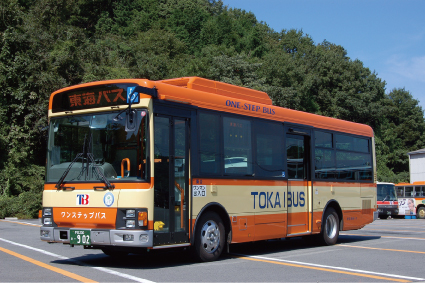
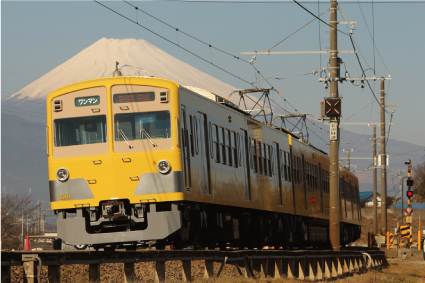
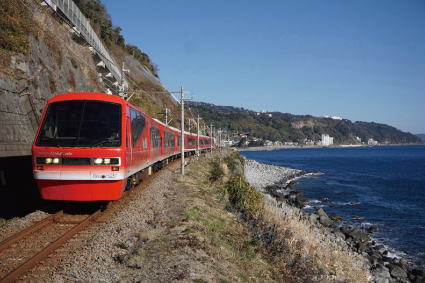
Regions of the Izu Peninsula
Izu Junior High School (Izunokuni City and Izu City)
[Characteristics] Located in the center of Izu, this area is famous for its hot spring towns, Shuzenji Onsen and Izunagaoka Onsen. Surrounded by the Amagi mountain range, it is located upstream of the Kano River, famous for sweetfish fishing. It is also famous for the Nirayama Reflection Furnace, a World Heritage Site, and the site of the launch of Hojo Yoshitoki and Minamoto no Yoritomo, who appeared in the recent historical drama.
[Transportation] The Izu-Hakone Railway runs through the center, with Shuzenji Station at its terminus.
[Food] Wasabi and shiitake mushrooms are also cultivated here, making it one of Japan's leading production areas. Ema strawberries are also famous, and Toi also produces rare white biwa.
Izu North (Atami City, Kannami Town, Mishima City, Numazu City)
[Characteristics] Atami is the best hot spring town in Japan, but Kinomiya Shrine is also famous. Mishima is known for its spring water from Mt. Fuji, and has been called the water city since ancient times. Kannami Town has a villa area, and many people have moved there from the metropolitan area, and part of Numazu City is a bay on the Izu Peninsula. *Nagaizumi Town and Shimizu Town are also included.
[Transportation] Atami and Mishima have JR Shinkansen stations, and you can get from Tokyo Station to Atami Station in 45 minutes.
[Food] Mishima has a history of prosperity as a post town, and is famous for eel. From Atami Station to Ginza Town, you can enjoy seafood, soba, and sweets.
Izu East (Ito City, Higashiizu Town, Kawazu Town)
[Characteristics] Ito Onsen is famous after Atami, but Ito is also a villa area, so it is a dog-friendly town. You can enjoy sightseeing at Jogasaki Coast, where you can enjoy the great outdoors, as well as Omuroyama and Komuroyama, which are listed in the Michelin Green Guide. Higashiizu is a town of traditional Japanese culture, the Doll Festival and Moon Road, and in Kawazu you can enjoy the famous Kawazu cherry blossoms.
[Transportation] JR trains run to Ito Station, and Izukyu trains run from Ito Station to Shimoda Station.
[Food] Ito is also a villa area, so there are also stylish cafes and Western restaurants. Inatori Fishing Port has long been known as a place where golden-eyed snapper is produced.
Izu Minami (Shimoda City and Minamiizu Town)
[Characteristics] Shimoda is known worldwide as the city where the Black Ships arrived and the country was opened to the world. You can feel the turbulent history of Japan related to the opening of the country, and it is introduced in the Michelin Green Guide as a city where you can enjoy Japan. Minamiizu is a treasure trove of nature, and you can enjoy Hirizo Beach, which boasts one of the clearest waters in Japan, as well as spectacular views, and the southernmost lighthouse and shrine in Izu are enshrined.
[Transportation] Shimoda Station, the terminus of the Izu Kyuko Line, is located here, but Minamiizu is also covered by the Tokai Bus transportation network.
[Food] Shimoda is famous for its red sea bream, but there are also many restaurants serving seafood and soba noodles. In Minamiizu, there are restaurants around Yumigahama and the Yunohana Roadside Station.
Izu West (West Izu, Matsuzaki Town)
[Characteristics] Although it is the farthest point in Izu in terms of distance, Nishiizu has many geosites of the Izu Geopark, including Dogashima, and is known for having the best sunsets in Japan. Matsuzaki Town is home to the Namako Wall and Iwaka School, the oldest school in Izu, and its streets are filled with history and culture. The hot spring towns of Matsuzaki, Iwaji, Ishibe, and Kumomi are lined up next to each other.
[Transportation] The base is the Matsuzaki bus terminal, which can be reached in about 1 hour and 30 minutes from Shuzenji Station.
[Food] Although it is in the countryside, there are many fishing ports, so there are many famous restaurants where you can enjoy fresh seafood. The boat lodges have a long history, and there are also guesthouses that serve fresh seafood dishes with incredible quality and value for money.